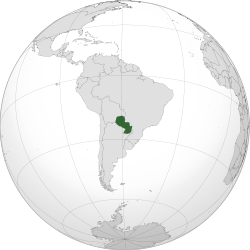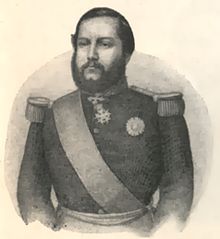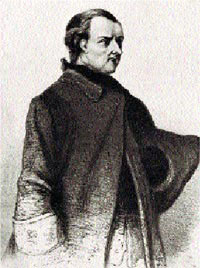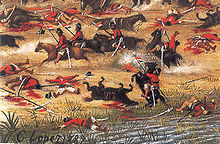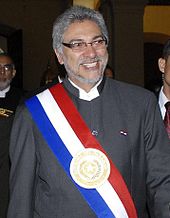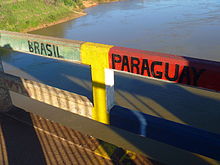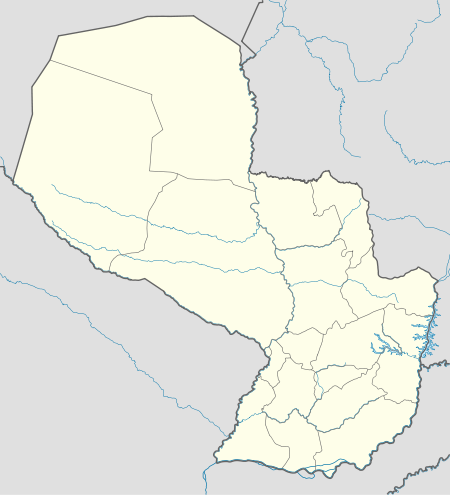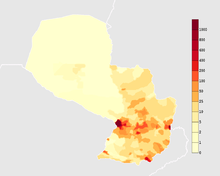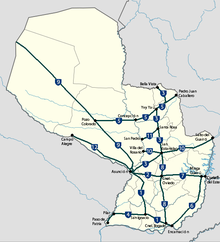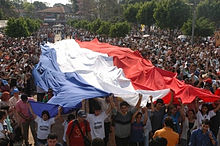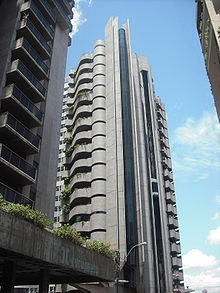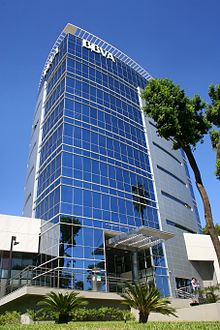
Paraguay
Background to the schools Wikipedia
SOS Children offer a complete download of this selection for schools for use on schools intranets. A good way to help other children is by sponsoring a child
Republic of Paraguay
|
||||||
|---|---|---|---|---|---|---|
|
||||||
| Motto: "Paz y justicia" (Spanish) "Peace and justice" |
||||||
| Anthem: Paraguayos, República o Muerte (Spanish) Paraguayans, Republic or Death |
||||||
Flag (reverse) |
||||||
|
|
||||||
| Capital and largest city |
Asunción 25°16′S 57°40′W |
|||||
| Official languages |
|
|||||
| Ethnic groups (2000) |
|
|||||
| Demonym | Paraguayan | |||||
| Government | Unitary presidential constitutional republic | |||||
| - | President | Federico Franco | ||||
| - | Vice President | Óscar Denis | ||||
| Legislature | Congress | |||||
| - | Upper house | Chamber of Senators | ||||
| - | Lower house | Chamber of Deputies | ||||
| Independence from Spain | ||||||
| - | Declared | 14 May 1811 | ||||
| - | Recognized | 15 May 1811 | ||||
| Area | ||||||
| - | Total | 406,752 km2 ( 60th) 157,048 sq mi |
||||
| - | Water (%) | 2.3 | ||||
| Population | ||||||
| - | 2011 estimate | 6,561,748 ( 104th) | ||||
| - | Density | 14.2/km2 ( 204th) 39/sq mi |
||||
| GDP ( PPP) | 2012 estimate | |||||
| - | Total | $48.643 billion | ||||
| - | Per capita | $5,827 | ||||
| GDP (nominal) | 2012 estimate | |||||
| - | Total | $38.584 billion | ||||
| - | Per capita | $5,358 | ||||
| Gini (2009) | 53.2 high |
|||||
| HDI (2012) | medium · 111th |
|||||
| Currency | Guaraní ( PYG) |
|||||
| Time zone | ( UTC-4) | |||||
| - | Summer ( DST) | ( UTC-3) | ||||
| Drives on the | right | |||||
| Calling code | +595 | |||||
| ISO 3166 code | PY | |||||
| Internet TLD | .py | |||||
| a. | Mixed European and Amerindian. | |||||
Paraguay (US / p ɛər ə ɡ w aɪ /, UK / p æ r ə ɡ w aɪ /), officially the Republic of Paraguay (Spanish: República del Paraguay [reˈpuβlika ðel paɾaˈɣwaj], Guaraní: Tetã Paraguái [teˈtã paɾaˈɣwaj]), is a landlocked country in South America, bordered by Argentina to the south and southwest, Brazil to the east and northeast, and Bolivia to the northwest. Paraguay lies on both banks of the Paraguay River, which runs through the centre of the country from north to south. Due to its central location in South America, it is sometimes referred to as Corazón de América ("Heart of America").
The Guaraní have been living in Paraguay since long before the arrival of Europeans in the 16th century, when Paraguay became part of the Spanish colonial empire. Following independence from Spain in 1811, Paraguay was ruled by a series of dictators who implemented repressive isolationist and protectionist policies. Its development was further truncated by the disastrous Paraguayan War (1864–1870), in which the country lost 60% to 70% of its population and large amounts of territory. Paraguay endured a succession of unstable and often authoritarian governments, culminating in the regime of Alfredo Stroessner, who led one of South America's longest-lived military dictatorships for a large part of the 20th century. In 1989, Stroessner was toppled in an internal coup, and free multiparty elections were held in 1993. A year later, Paraguay joined Argentina, Brazil and Uruguay to found Mercosur.
As of 2009, Paraguay's population was estimated to be at around 6.5 million, most of whom are concentrated in the southeast region of the country. The capital and largest city is Asunción, of which the metropolitan area is home to nearly a third of the Paraguay's population. In contrast to most Latin American nations, Paraguay's indigenous language and culture remains widespread, with the vast majority of the population identifying as mestizo. This influence is reflected in Guaraní's status as an official language, alongside Spanish. Both languages are widely-spoken in the country, with around 92% of the general population speaking Spanish and 98% speaking Guaraní.
Paraguay has long been one of the region's poorest and most isolated countries, although it has experienced consistent economic growth since the 21st century. In 2010, the economy grew by 14.5%, the largest economic expansion in Latin America, and the third fastest in the world (after Qatar and Singapore). By 2011, economic growth had slowed to 6.4%, but remained far higher than the global average. Nevertheless, widespread poverty, socioeconomic inequality, and poor governance remain persistent challenges.
Etymology
The name of the river, Paraguay, is thought to come from Guaraní para, "of many varieties", and gua, "riverine".
There is no conclusive explanation for the origin of the name Paraguay, however. The most common interpretations that have been suggested include:
- "River which originates a sea"
- The Spanish officer and scientist Félix de Azara suggests two versions: water from the Payaguas (Payaguá-ý", or "river of Payaguás"), referring to the Indian tribe that lived on the river, and the other was due to the name of a great chief called "Paraguaio."
- The French-Argentine historian and writer Paul Groussac argued that it meant "river that flows through the sea (Pantanal)."
- The ex-president and Paraguayan politician, Juan Natalicio González said it meant "river of the habitants of the sea."
- Fray Antonio Ruiz de Montoya said that it meant "river crowned."
History
Precolumbian Paraguay
Pre-Columbian society in the region which is now Paraguay consisted of semi-nomadic tribes, who were recognized for their warrior traditions. These indigenous tribes were members of five distinct language families, and 17 separate ethnolinguistic groups remain today.
First European contact (1516)
Europeans first arrived in the area in 1516. The settlement of Asunción was founded on 15 August 1537, by the Spanish explorer Juan de Salazar de Espinosa. The city eventually became the centre of a Spanish colonial province, as well as the primary site of the Jesuit missions and settlements in South America in the eighteenth century. Jesuit Reductions were founded, and flourished in Eastern Paraguay for about 150 years, until the expulsion of the Jesuits by the Spanish crown in 1767.
Independence from Spain (1811)
Paraguay overthrew the local Spanish administration on 15 May 1811. Paraguay's first ruler was the dictator José Gaspar Rodríguez de Francia. He ruled Paraguay from 1814, until his death in 1840, with very little outside contact or influence, creating a utopian society based on Rousseau's Social Contract. He established new laws that more or less completely removed the powers of the church and the cabinet, forbade colonial citizens from marrying one another, being allowed to marry only blacks, mulattoes or natives, and cut off Paraguay from the rest of South America. Because of de Francia's restrictions on personal freedom, Fulgencio Yegros and several other military leaders and former politicians, planned a coup d'état against him. This was discovered by de Francia, and its leaders either executed or imprisoned for life.
After his death, Paraguay went through the very brief ownership of various military officers under a new junta, until the secretary Carlos Antonio López, Francia's nephew, declared himself dictator. Lopez modernized Paraguay, and opened it up to foreign commerce. The relationship with Buenos Aires was limited to a non-aggression pact; Paraguayan independence from Argentina was declared in 1842. After Lopez's death, power was transferred to his eldest son, Francisco Solano López in 1862.
The Paraguayan War commenced in 1864. Paraguay fought against Brazil, Argentina and Uruguay, and was defeated in 1870 after five years of the bloodiest war in South America. William D. Rubinstein wrote: "The normal estimate is that of a Paraguayan population of somewhere between 450,000 and 900,000, only 220,000 survived the war, of whom only 28,000 were adult males." Paraguay also suffered extensive territorial losses to Brazil and Argentina.
The Chaco War was fought with Bolivia in the 1930s, and Bolivia was defeated. Paraguay re-established sovereignty over the region called the Chaco, but forfeited additional territorial gains as a price of peace.
The official narrative of Paraguay's history is fraught with disputes among historians, educators and politicians. The "authentic" version of historical events, wars in particular, varies depending on whether it was written in Paraguay, Argentina, Uruguay, Brazil, Bolivia, Europe, or North America.
Both the Colorado Party and Liberal Party maintain distinct official versions of Paraguayan history. During the pillaging of Asunción (Saqueo de Asunción) in 1869, the Brazilian Imperial Army ransacked and relocated the Paraguayan National Archives to Rio de Janeiro where they have been kept in secrecy, making Paraguayan history in the Colonial and early National periods difficult to study.
20th century
Between 1904 and 1954, Paraguay had thirty-one presidents, most of whom were removed from office by force.
After World War II, politics became particularly unstable, with several political parties fighting for power in the late 1940s, which most notably brought about the Paraguayan civil war of 1947. A series of unstable governments ensued until the establishment, in 1954, of the stable regime of dictator Alfredo Stroessner, who remained in office for more than three decades, until 1989. Paraguay was modernized to some extent under Stroessner's regime, although his rule was marked by extensive abuses.
Stroessner and the Colorado party ruled the country from 1954 to 1989. The dictator oversaw an era of economic expansion, but also had a poor human rights and environmental record (see "Political History"). Torture and death for political opponents was routine. After his overthrow, the Colorado continued to dominate national politics until 2008.
Post-1979
The splits in the Colorado Party in the 1980s, and the conditions that led to this — Stroessner's advanced age, the character of the regime, the economic downturn, and international isolation — provided an opportunity for demonstrations and statements by the opposition prior to the 1988 general elections.
PLRA leader Domingo Laino served as the focal point of the opposition in the second half of the 1980s. The government's effort to isolate Laino by exiling him in 1982 had backfired. On his sixth attempt, in 1986, Laino returned with three television crews from the U.S., a former United States ambassador to Paraguay, and a group of Uruguayan and Argentine congressmen. Despite the international contingent, the police violently barred Laino's return.
However, the Stroessner regime relented in April 1987, and permitted Laino to arrive in Asunción. Laino took the lead in organizing demonstrations and diminishing somewhat the normal opposition party infighting. The opposition was unable to reach agreement on a common strategy regarding the elections, with some parties advocating abstention, and others calling for blank voting. Nonetheless, the parties did cooperate in holding numerous 'lightning demonstrations' (mítines relámpagos), especially in rural areas. Such demonstrations were held and disbanded quickly before the arrival of the police.
In response to the upsurge in opposition activities, Stroessner condemned the Accord for advocating "sabotage of the general elections and disrespect of the law", and used the national police and civilian vigilantes of the Colorado Party to break up demonstrations. A number of opposition leaders were imprisoned or otherwise harassed. Hermes Rafael Saguier, another key leader of the PLRA, was imprisoned for four months in 1987 on charges of sedition. In early February 1988, police arrested 200 people attending a National Coordinating Committee meeting in Coronel Oviedo. Laino and several other opposition figures were arrested before dawn on the day of the election, 14 February, and held for twelve hours. The government declared Stroessner's re-election with 89% of the vote.
While contending that these results reflected the virtual Colorado monopoly on the mass media, opposition politicians also saw several encouraging developments. Some 53% of those polled indicated that there was an "uneasiness" in Paraguayan society. Furthermore, 74% believed that the political situation needed changes, including 45% who wanted a substantial or total change. Finally, 31% stated that they planned to abstain from voting in the February elections.
On 3 February 1989, Stroessner was overthrown in a military coup headed by General Andrés Rodríguez. As president, Rodríguez instituted political, legal, and economic reforms and initiated a rapprochement with the international community.
The June 1992 constitution established a democratic system of government and dramatically improved protection of fundamental rights. In May 1993, Colorado Party candidate Juan Carlos Wasmosy was elected as Paraguay's first civilian president in almost 40 years, in what international observers deemed fair and free elections.
With support from the United States, the Organization of American States, and other countries in the region, the Paraguayan people rejected an April 1996 attempt by then Army Chief General Lino Oviedo to oust President Wasmosy.
Oviedo became the Colorado candidate for president in the 1998 election, but when the Supreme Court upheld in April his conviction on charges related to the 1996 coup attempt, he was not allowed to run and remained in confinement. His former running mate, Raúl Cubas, became the Colorado Party's candidate, and was elected in May in elections deemed by international observers to be free and fair. One of Cubas' first acts after taking office in August was to commute Oviedo's sentence and release him from confinement. In December 1998, Paraguay's Supreme Court declared these actions unconstitutional. In this tense atmosphere, the murder of Vice President and long-time Oviedo rival Luis María Argaña on 23 March 1999, led the Chamber of Deputies to impeach Cubas the next day. The 26 March murder of eight student antigovernment demonstrators, widely believed to have been carried out by Oviedo supporters, made it clear that the Senate would vote to remove Cubas on 29 March, and Cubas resigned on 28 March. Senate President Luis González Macchi, a Cubas opponent, was peacefully sworn in as president the same day.
In 2003, Nicanor Duarte Frutos was elected and sworn in as president.
For the 2008 general elections, the Colorado Party was once again a favorite. This time, their candidate was not an internal opponent to the President and self-proclaimed reformer, as in the two previous elections, but Minister of Education Blanca Ovelar, the first woman to appear as a candidate for a major party in Paraguayan history. However after sixty years of Colorado rule, voters chose a non-politician, former Roman Catholic Bishop Fernando Lugo. Although he was a longtime follower of the controversial liberation theology he was backed by the centre-right Liberal Party, the Colorado Party's traditional opponents.
Lugo achieved a historic victory in Paraguay's presidential election, defeating the ruling party candidate, and ending 61 years of conservative rule. Lugo won with nearly 41% of the vote, compared to almost 31% for Blanca Ovelar of the Colorado party. Outgoing President Nicanor Duarte Frutos hailed the moment as the first time in the history of the nation that a government had handed power to opposition forces in an orderly and peaceful fashion.
Lugo was sworn in on 15 August 2008, but unlike other South American countries such as Venezuela, Ecuador and Bolivia, Lugo's leftist agenda remains largely unimplemented as the Paraguayan Congress continues to be dominated by right-wing elected officials. The Lugo administration has highlighted the reduction of corruption and economic inequality as two major priorities.
Political instability in the past year, fueled by disputes within Fernando Lugo's cabinet, has led the right wing Colorado Party to regain popularity. Reports suggest that the businessman Horacio Cartes is the new political figure amid disputes. Despite the US Drug Enforcement Administration's strong accusations against Cartes involving him in drug trafficking, he continues to amass followers in the political arena.
On 14 January 2011, the Colorado Party convention enabled Horacio Cartes to run as the presidential candidate for the party, even though, as reports suggest, the party's constitution didn't allow it.
On 21 June 2012, impeachment proceedings against President Lugo began in the country's lower house, controlled by his opponents. Lugo was given less than twenty-four hours to prepare for the proceedings and only two hours in which to mount a defense. Impeachment was quickly approved and the resulting trial in Paraguay's Senate, also controlled by the opposition, ended with the removal of Lugo from office and Vice President Federico Franco assuming the duties of president. Lugo's rivals blame him for the deaths of 17 people - eight police officers and nine farmers - in armed clashes after police were ambushed by armed peasants when enforcing an eviction order against trespassers.
Lugo's supporters quickly gathered outside Congress to protest the decision as a "politically motivated coup d'état". Lugo's removal from office on June 22, 2012 is considered by UNASUR and other neighboring countries, especially those currently governed by leftist leaders, as a coup d'état. However, the Organization of American States, which sent a mission to Paraguay to gather information on the impeachment process, concluded that no coup d'état had occurred and that the impeachment process had been carried out in accordance with the Constitution of Paraguay.
On 17 October 2012, Venezuela's government expelled Paraguay's remaining diplomats from Venezuela. Chargé d'affaires Victor Casartelli said that he and three other Paraguayan diplomats in Caracas were told leave within three days. This follows a dispute between the countries that began in June 2012 with the congressional impeachment and ouster of Paraguayan President Fernando Lugo.
Government and politics
Paraguay is a representative democratic republic, with a multi-party system and separation of powers in three branches. Executive power is exercised solely by the President, who is head of state and head of government. Legislative power is vested in the two chambers of the National Congress. The judiciary is vested on tribunals and Courts of Civil Law and a nine-member Supreme Court of Justice, all of them independent of the executive and the legislature.
Administrative subdivisions
Paraguay consists of seventeen departments and one capital district (distrito capital).
It is also divided into 2 regions: The "Occidental Region" or Chaco (Boquerón, Alto Paraguay and Presidente Hayes), and the "Oriental Region" (the other departments and the capital district).
These are the departments, with their capitals, population, area and the number of districts:
Paraná
| ISO 3166-2:PY | Departament | Capital | Population (2002 census) | Area (km²) | Districts |
|---|---|---|---|---|---|
| ASU | Distrito Capital | Asunción | 512,112 | 117 | 6 |
| 1 | Concepción | Concepción | 179,450 | 18,051 | 8 |
| 2 | San Pedro | San Pedro | 318,698 | 20,002 | 20 |
| 3 | Cordillera | Caacupé | 233,854 | 4,948 | 20 |
| 4 | Guairá | Villarrica | 178,650 | 3,846 | 18 |
| 5 | Caaguazú | Coronel Oviedo | 435,357 | 11,474 | 21 |
| 6 | Caazapá | Caazapá | 139,517 | 9,496 | 10 |
| 7 | Itapúa | Encarnación | 453,692 | 16,525 | 30 |
| 8 | Misiones | San Juan Bautista | 101,783 | 9,556 | 10 |
| 9 | Paraguarí | Paraguarí | 221,932 | 8,705 | 17 |
| 10 | Alto Paraná | Ciudad del Este | 558,672 | 14,895 | 21 |
| 11 | Central | Areguá | 1,362,893 | 2,465 | 19 |
| 12 | Ñeembucú | Pilar | 76,348 | 12,147 | 16 |
| 13 | Amambay | Pedro Juan Caballero | 114,917 | 12,933 | 4 |
| 14 | Canindeyú | Salto del Guairá | 140.137 | 14.667 | 12 |
| 15 | Presidente Hayes | Villa Hayes | 82,493 | 72,907 | 8 |
| 16 | Alto Paraguay | Fuerte Olimpo | 11,587 | 82,349 | 4 |
| 17 | Boquerón | Filadelfia | 41,106 | 91,669 | 3 |
| - | Paraguay | Asunción | 5,163,198 | 406,752 | 245 |
The departments are further divided into districts (distritos).
Demographics
There is no official data on the ethnic composition of the Paraguayan population, as the Department of Statistics, Surveys and Censuses of Paraguay does not ask about race and ethnicity in census surveys, although it does inquire about the indigenous population. According to the census of 2002, the indigenous people made up 1.7% of Paraguay's total population.
Traditionally, the majority of the Paraguayan population is considered mixed (mestizo in Spanish), owing to the widespread pairing of Guaraní women with male Spanish settlers during Spain's colonization of the country.
According to the CIA World Factbook, Paraguay has a population of 6,669,086, 95% of which are mestizo (mixed European and Amerindian) and 5% are labelled as "other", which includes members of indigenous tribal groups. They are divided into 17 distinct ethnolinguistic groupings, many of which are poorly documented.
One remarkable trace of the indigenous Guaraní culture that has endured in Paraguay is the Guaraní language, which is generally understood by about 90% of the population. Additionally, nearly all Paraguayans also speak Spanish, which alongside Guaraní is an official language. For most of its history, Paraguay has been a recipient of immigrants, owing to its low population density, especially after the demographic collapse that resulted from the Paraguayan War. Small groups of ethnic Italians, Germans, Russians, Japanese, Koreans, Chinese, Arabs, Ukrainians, Brazilians, and Argentinians have also settled in Paraguay. Many of these communites have retained their languages and culture, particularly the Brazilians, who represent the largest and most prominent immigrant group, at around 400,000. Many Brazilian Parguayans are of German, Italian and Polish descent. There are an estimated 63,000 Afro-Paraguayans, comprising 1% of the population.
Paraguay has one of the most prominent German communities in South America, with some 25,000 German-speaking Mennonites living in the Paraguayan Chaco.German settlers founded several towns as Hohenau, Filadelfia, Neuland, Obligado and Nueva Germania. Several websites that promote German immigration to Paraguay claim that 5–7% of the population is of German ancestry, including 150,000 people of German-Brazilian descent.
Paraguay's population is distributed unevenly through the country, with the vast majority of people living in the eastern region near the capital and largest city, Asunción, which accounts for 10% of the country's population. The Gran Chaco region, which includes the Alto Paraguay, Boquerón and Presidente Hayes Department, and accounts for about 60% of the territory, is home to less than 2% of the population. About 56% of Paraguayans live in urban areas, making Paraguay one of the least urbanized nations in South America.
Largest cities
Religion
Christianity, particularly Roman Catholicism, is the dominant religion in Paraguay. According to the 2002 census, 89.9% of the population is Catholic, 6.2% is evangelical Christian, 1.1% identify with other Christian sects, and 0.6% practice indigenous religions. A U.S. State Department report on Religious Freedom names Roman Catholicism, Evangelical Christianity, mainline Protestantism, Judaism (Orthodox, Conservative, and Reform), Mormonism, and the Baha'i Faith as prominent religious groups. It also mentions a large Muslim community in Alto Paraná (as a result of Middle-Eastern immigration, especially from Lebanon) and a prominent Mennonite community in Boquerón.
Social issues
Various poverty estimates suggest that 30–50% of the population is poor. In rural areas, 41.20% of the people lack a monthly income to cover basic necessities, whereas in urban centers this figure is 27.6%. The top 10% of the population holds 43.8% of the national income, while the lowest 10% has 0.5%. The economic recession has worsened income inequality, notably in the rural areas, where the Gini coefficient has risen from 0.56 in 1995 to 0.66 in 1999.
More recent data (2009) show that 35% of the Paraguayan population is poor, 19% of which live in extreme poverty. Moreover, 71% of the latter live in rural areas of the country.
Similarly, land concentration in the Paraguayan countryside is one of the highest in the globe: 10% of the population controls 66% of the land, while 30% of the rural people are landless. This inequality has caused a great deal of tensions between the landless and land owners.
Economy
Landlocked Paraguay has a market economy distinguished by a large informal sector, featuring re-export of imported consumer goods to neighboring countries, as well as the activities of thousands of microenterprises and urban street vendors. Between 1970 and 2009 the country had the highest economic growth of South America, with an average rate of 7.2% per year and the prospect of 9% annual growth from 2010, being the highest in South America.
The country also boasts the third most important free commercial zone in the world: Ciudad del Este, trailing behind Miami and Hong Kong. A large percentage of the population, especially in rural areas, derives its living from agricultural activity, often on a subsistence basis. Because of the importance of the informal sector, accurate economic measures are difficult to obtain. On a per capita basis, real income has stagnated at 1980 levels. The economy grew rapidly between 2003 and 2008 as growing world demand for commodities combined with high prices and favorable weather to support Paraguay's commodity-based export expansion. Paraguay is the sixth largest soy producer in the world. Drought hit in 2008, reducing agricultural exports and slowing the economy even before the onset of the global recession.
In 2010, Paraguay experienced the greatest economic expansion of the zone and the highest of South America, with a GDP growth rate of 14.5% by the end of the year. The following year, Paraguay's growth rate remained a relatively high 6.4%;
Industry and Manufacturing
The industrial sector produces about 25% of Paraguay's gross domestic product (GDP) and employs about 31% of the labor force. Output grew by 2.9% in 2004, after five years of declining production. Traditionally an agricultural economy, Paraguay is showing some signs of long-term industrial growth.
The pharmaceutical industry is quickly supplanting foreign suppliers in meeting the country's drug needs. Paraguayan companies now meet 70% of domestic consumption and have begun to export drugs. Strong growth also is evident in the production of edible oils, garments, organic sugar, meat processing, and steel.
Nevertheless, capital for further investment in the industrial sector of the economy is scarce. Following the revelation of widespread financial corruption in the 1990s, the government is still working to improve credit options for Paraguayan businesses.
In 2003, manufacturing made up 13.6% of the GDP, and the sector employed about 11% of the working population in 2000. Paraguay's primary manufacturing focus is on food and beverages. Wood products, paper products, hides and furs, and non-metallic mineral products also contribute to manufacturing totals. Steady growth in the manufacturing GDP during the 1990s (1.2% annually) laid the foundation for 2002 and 2003, when the annual growth rate rose to 2.5%.
Education
Literacy was about 93.6% and 87.7% of Paraguayans finish the 5th grade according to UNESCO's last Educational Development Index 2008. Literacy does not differ much by gender. A more recent study reveals that attendance at primary school by children between 6 and 12 years old is about 98%. Primary education is free and mandatory and takes nine years. Secondary education takes three years. Paraguay's universities include:
- National University of Asunción (public and founded in 1889)
- Autonomous University of Asunción (private and founded in 1979)
- Catholic University (private and run by the church).
- American University (private).
The net primary enrollment rate was at 88% in 2005. Public expenditure on education was about 4.3% of GDP in the early 2000s.
Health
Average life expectancy in Paraguay is rather high given its poverty: as of 2006, it was 75 years, equivalent to far wealthier Argentina, and the 8th highest in the Americas according to World Health Organization. Public expenditure on health is 2.6% of GDP, while private health expenditure is 5.1%. Infant mortality was 20 per 1,000 births in 2005. Maternal mortality was 150 per 100,000 live births in 2000. The World Bank has helped the Paraguayan government reduce the country's maternal and infant mortality. The Mother and Child Basic Health Insurance Project aimed to contribute to reducing mortality by increasing the use of selected life-saving services included in the country's Mother and Child Basic Health Insurance Program (MCBI) by women of child-bearing age, and children under age six in selected areas. To this end, the project also targeted improving the quality and efficiency of the health service network within certain areas, in addition to increasing the Ministry of Public Health and Social Welfare's (MSPBS) management.


